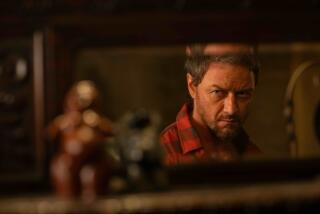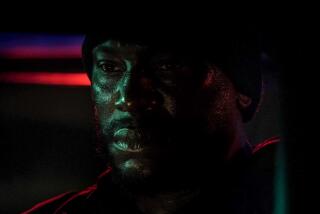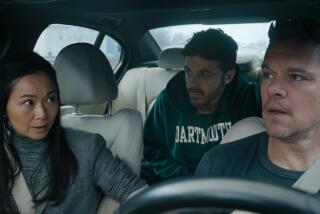‘The Purge: Anarchy’ a grim improvement on the original, reviews say
“The Purge: Anarchy” has arrived in theaters wearing its violence and its politics on its black-clad sleeves. Writer-director James DeMonaco’s sequel to his low-budget 2013 sleeper hit “The Purge” takes the premise of an annual night of government-sanctioned mayhem out of suburbia and into the streets of downtown Los Angeles, where literal class warfare erupts.
Many critics agree that “Anarchy” is an improvement on the original, but whether it makes for a movie worth seeing depends on whom you ask — and how you feel about excessive bloodletting and heavy-handed social commentary.
The Times’ Betsy Sharkey writes, “‘The Purge: Anarchy’ is a good deal bloodier, but also — gulp — a good deal better than its predecessor. Make no mistake, a good ‘Purge’ does not equal a good movie, but the post-apocalyptic thriller is slightly more interesting because it takes itself, and its menace, more seriously.”
The film benefits from “a strong trio in Frank Grillo, Carmen Ejogo and Zoe Soul,” Sharkey says, and she predicts “by building a marginally better ‘Anarchy,’ no doubt we’re in for another purge next year.”
The New York Times’ Manohla Dargis calls “Anarchy” a “satisfyingly creepy, blunt, down-and-dirty thriller, one of those follow-ups that improves on the original.” She adds that “DeMonaco has opened up the story narratively and spatially,” and he keeps things “nasty and simple, giving the movie an accordion-like rhythm by consistently bringing you close to the characters, only to pull back to show just how imperiled they are.”
The Chicago Sun-Times’ Bruce Ingram disagrees, writing that “the wickedly satiric sense of humor that made the original worth watching is nowhere to be found.” The original film had “occasional flashes of scathing wit” to go with its “grim, brutal violence,” Ingram says. “In ‘The Purge: Anarchy,’ unfortunately, grim and brutal is pretty much all we get.”
The Washington Post’s Michael O’Sullivan says the film’s “attempt to tap into lingering rage over the financial crisis and income inequality is understandable, if heavy-handed.” The problem, O’Sullivan says, is that “Anarchy” “substitutes an almost cartoonish level of violence for what at least passed for social commentary in the original ‘Purge.’ That movie was bloody and had a high body count, too, but it made its point with metaphorical skewers, not machetes.”
The Boston Globe’s Loren King writes, “Give credit to writer-director James DeMonaco for at least attempting to give his action thriller some heft with a plot that concerns our obsession with violence, ham-fisted as it is. But ‘The Purge: Anarchy’ is still just an excuse to bombard us with high-powered weaponry, armored vehicles, vigilantes, and masked marauders in creepy Joker-like makeup.”
In other words, King says, “The film wants to have it both ways: It mixes sanctimonious commentary about violence and socioeconomic claptrap with grand depictions of violent assaults and terror on cue.”
USA Today’s Claudia Puig says that “‘Anarchy” is “more unsettling” than its predecessor and “features more in-your-face commentary about class warfare” that other recent dystopia-themed movies like “The Hunger Games” and “Dawn of the Planet of the Apes.”
In the end, Puig says, “While the film is rutted with plot holes, lapses in logic and tin-eared dialogue — the obvious is stated again and again — it falls squarely into a category that used to be called B movies. The jarring action and outlandish premise of a lawless free-for-all are somehow riveting and inane in almost equal measures.”
Follow @ogettell for movie news
More to Read
Only good movies
Get the Indie Focus newsletter, Mark Olsen's weekly guide to the world of cinema.
You may occasionally receive promotional content from the Los Angeles Times.








